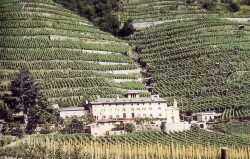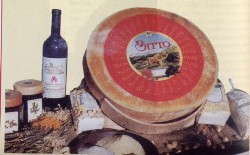Valtellina
The
Valtellina has been known and appreciated as a territory dedicated  to
the production of great red wines for ageing since remote times. It was
probably the Celto-Ligurians, having learnt the techniques from the Etruscans,
who began vine cultivation in the valley. Later, in the Carolingian period,
the Germanic populations began to trade wines along the Roman roads that
crossed the Alpine passes and travelled along the Rhine valley to reach
the major centres such as Zurich,
to
the production of great red wines for ageing since remote times. It was
probably the Celto-Ligurians, having learnt the techniques from the Etruscans,
who began vine cultivation in the valley. Later, in the Carolingian period,
the Germanic populations began to trade wines along the Roman roads that
crossed the Alpine passes and travelled along the Rhine valley to reach
the major centres such as Zurich,  Hamburg
and the cities of northern Germany. The Viscontis and the Sforzas, to
ensure that they would not be without this precious nectar of Bacchus,
extended special privileges to the inhabitants of the valley. Leonardo
da Vinci himself, speaking of the Valtellina wines, defined them as "fairly
powerful wines".
Hamburg
and the cities of northern Germany. The Viscontis and the Sforzas, to
ensure that they would not be without this precious nectar of Bacchus,
extended special privileges to the inhabitants of the valley. Leonardo
da Vinci himself, speaking of the Valtellina wines, defined them as "fairly
powerful wines".
In the course of more than ten centuries
of enological history and tradition, men of letters and poets, among them
Carducci, have found a way of extolling the virtues of the Valtellina
 wines
in their immortal works. This of the Valtellina is a mountain viticulture,
where every square metre dedicated to the vine has been painstakingly
created, the bare rock covered with earth laboriously carried up from
the valley, and then protected by an infinity of dry-stone walls known
as "murachi".
wines
in their immortal works. This of the Valtellina is a mountain viticulture,
where every square metre dedicated to the vine has been painstakingly
created, the bare rock covered with earth laboriously carried up from
the valley, and then protected by an infinity of dry-stone walls known
as "murachi".
|
The DOC wines
|
|
Many indigenous grapes have been present for centuries in Valtellina, but Nebbiolo proves to be the historically selected variety. Nowadays it is used pure in the classic Valtellina Docg and Doc wines. Valtellina Superiore (D.O.C.G.)
Valtellina (D.O.C.)
IGT wines "Terrazze retiche di Sondrio" The various types included in the IGT (typical geographical indication) "Terrazze retiche di Sondrio" are ready to drink red and white wines: being lighter, with more subtle aromas and perfumes, they are more popular with the young and for everyday drinking. |